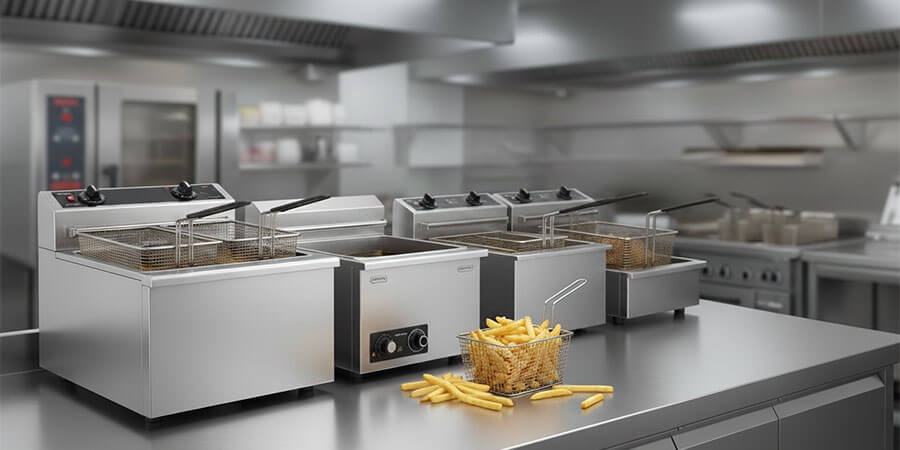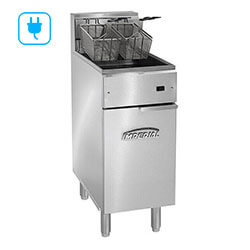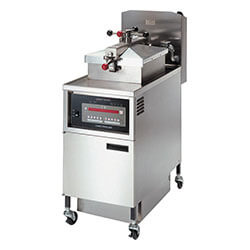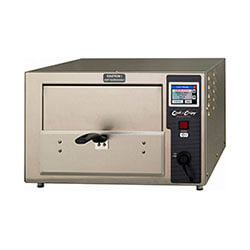Commercial Fryer Guide

Table of Contents
Comprehensive guide to choosing gas fryers, electric fryers, ventless fryers, pressure fryers, specialty fryers, and air fryers for your commercial kitchen
Commercial fryers provide the power and versatility needed for high-volume foodservice operations, from crispy French fries and fried chicken to specialty items like funnel cakes and donuts. Each type serves specific applications with distinct advantages, helping operators select equipment that matches their menu requirements, production volume, and operational constraints. Understanding these differences ensures you're investing in fryers that support your operation's efficiency, food quality, and profitability.
Types of Commercial Fryers
Commercial fryers fall into six primary categories, each optimized for specific applications and operational environments.
Gas Fryers
High-BTU floor-standing fryers designed for high-volume restaurant and QSR operations requiring rapid heat recovery and continuous frying capacity. These professional-grade units feature powerful gas burners ranging from 90,000 to 255,000 BTU/hr to handle demanding tasks like commercial French fry production, fried chicken, and high-volume menu items. Their large-capacity oil tanks (30-150+ lbs) and robust construction make them suitable for continuous operation in busy restaurant environments, where equipment reliability and rapid production capabilities are critical for maintaining service efficiency.

- Best Uses: French fries, fried chicken, fish, appetizers, high-volume menu items
- Key Features: High BTU output (90,000-255,000), large oil capacity (30-150+ lbs), fast recovery times, floor-standing models
- Production Capacity: Suitable for operations preparing 200-1,000+ servings daily depending on menu complexity
- Pros: Fast heat recovery, high-volume capacity, cost-effective fuel in many regions, durable construction withstands heavy use
- Cons: Requires gas line installation, higher ventilation requirements, louder operation during peak hours
Electric Fryers
Precision-controlled fryers offering consistent temperature management for cafes, smaller restaurants, and operations requiring exact cooking results. These units feature electric heating elements ranging from 1,800 to 24,000 watts designed for applications requiring stable temperatures and energy efficiency. Their compact designs (countertop and floor models) with oil capacities from 10-80 lbs make them ideal for operations with limited space or precise cooking needs, where consistent food quality and ease of installation are priorities.

- Best Uses: Seafood, vegetables, delicate items, smaller batch cooking, cafes and bistros
- Key Features: Precise temperature control, energy-efficient operation, compact designs, consistent heating
- Production Capacity: Optimized for 50-300 servings daily depending on operation size
- Pros: Precise temperature control, easier installation (no gas lines), quieter operation, energy-efficient for smaller loads
- Cons: Slower recovery times than gas, higher operating costs in some regions, limited to smaller capacities
Ventless Fryers
Self-contained fryers designed for operations where traditional hood systems aren't available or practical, featuring built-in filtration and exhaust systems. These specialized units combine frying capability with air purification technology, allowing safe operation in spaces like food trucks, kiosks, office buildings, and concession stands. With oil capacities of 45-70 lbs and built-in filtration systems, they provide the convenience of hoodless operation while maintaining air quality and food safety standards.

- Best Uses: Concession stands, food trucks, kiosks, office cafeterias, temporary events
- Key Features: Built-in air filtration, hoodless operation, self-contained exhaust, compact footprints
- Production Capacity: Suitable for 100-400 servings daily in constrained environments
- Pros: No hood installation required, space-efficient, built-in filtration extends oil life, safe for various locations
- Cons: Higher initial cost, limited to specific capacity ranges, requires regular filter maintenance
Pressure Fryers
High-efficiency fryers that cook food faster while retaining moisture and tenderness, particularly suited for fried chicken and other proteins. These units operate under pressure to reduce cooking times by up to 40% while sealing in natural juices and producing crispy exteriors. With electric heating elements (10.5-11.25 kW) and oil capacities of 43-75 lbs, they feature built-in filtration systems and programmable controls for consistent, high-quality results in dedicated fried chicken restaurants and high-volume protein operations.

- Best Uses: Fried chicken, chicken tenders, fish, proteins requiring moisture retention
- Key Features: Pressure cooking technology, faster cook times, built-in filtration, moisture retention
- Production Capacity: Critical for operations serving 300-800 protein items daily
- Pros: Faster cooking times, superior moisture retention, consistent quality, built-in oil management
- Cons: Higher equipment cost, specialized for protein applications, requires specific maintenance procedures
Specialty Fryers
Versatile fryers designed for specific applications like funnel cakes, donuts, and other concession items requiring unique cooking profiles. These units feature specialized heating systems and tank designs optimized for batter-based products and shaped items. With gas or electric power options and oil capacities from 30-170 lbs, they provide the flexibility needed for concession stands, fairgrounds, and restaurants offering specialty fried desserts and treats.

- Best Uses: Funnel cakes, donuts, elephant ears, specialty fried desserts, concession items
- Key Features: Specialized tank designs, batter-friendly heating, flexible power options, event-focused construction
- Production Capacity: Optimized for 100-500 specialty items daily depending on operation type
- Pros: Specialized for unique menu items, flexible production, suitable for events and concessions, cost-effective for targeted menus
- Cons: Limited to specific product types, may require specialized batter handling, event-focused rather than daily use
Air Fryers
Convection-based cooking systems that use hot air circulation to produce crispy results with little to no oil, offering healthier alternatives to traditional frying. These countertop units feature rapid air technology that crisps food surfaces while maintaining interior moisture, making them ideal for health-conscious menus and smaller operations. With electric heating elements (1,500-3,500 watts) and basket capacities from 10-25 lbs, they provide oil-free cooking options for restaurants wanting to offer lighter menu choices.

- Best Uses: Health-focused menu items, smaller portions, appetizers, vegetables, proteins, lighter fare
- Key Features: Oil-free cooking, rapid air circulation, digital controls, compact countertop design
- Production Capacity: Suitable for 50-200 lighter items daily in health-focused or smaller operations
- Pros: No oil required, healthier cooking method, faster cooking times, energy-efficient, easy cleanup
- Cons: Limited to smaller batch sizes, not suitable for traditional fried items, higher equipment cost per serving
Fryer Type Comparison
| Type: | Primary Application: | Fuel Type: | Capacity Range: | Best Environment: |
| Gas Fryers | High-volume frying | Natural Gas/Propane | 30-150+ lbs | Restaurants, QSRs |
| Electric Fryers | Precision cooking | Electric | 10-80 lbs | Cafes, smaller operations |
| Ventless Fryers | Constrained spaces | Electric | 45-70 lbs | Kiosks, food trucks |
| Pressure Fryers | Protein frying | Electric | 43-75 lbs | Fried chicken restaurants |
| Specialty Fryers | Concession items | Gas/Electric | 30-170 lbs | Events, concessions |
| Air Fryers | Health-focused cooking | Electric | 10-25 lbs | Health-conscious operations |
Key Applications Comparison
Gas Fryers excel at high-volume production including commercial French fry operations, fried chicken restaurants, and QSR chains where speed and capacity are essential for maintaining service flow.
Electric Fryers are ideal for operations requiring precise temperature control, such as seafood restaurants, upscale dining establishments, and smaller cafes where food quality consistency is paramount.
Ventless Fryers provide flexibility for non-traditional locations including food trucks, concession stands, and office buildings where hood installation is impractical or prohibited.
Pressure Fryers are specialized for protein cooking where moisture retention and faster production are critical, particularly in dedicated fried chicken operations and high-volume protein-focused restaurants.
Specialty Fryers serve niche markets focused on concession items, fairgrounds, and restaurants offering unique fried desserts where standard frying equipment doesn't meet the specific product requirements.
Air Fryers provide oil-free alternatives for health-conscious menus, using convection heating to achieve crispy results without traditional frying methods, making them suitable for operations wanting to offer lighter menu options.
Features & Accessories
Understanding technical specifications helps match fryer capabilities to your operational requirements.
Oil Capacity & Heating Specifications
Production Capacity Ranges
- Small Operations (Cafes, Small Restaurants): 10-30 lbs oil capacity, suitable for 50-150 servings daily
- Medium Operations (Restaurants, Delis): 30-75 lbs oil capacity, handles 150-400 servings daily
- Large Operations (QSR, High-Volume): 75-150+ lbs oil capacity, supports 400-1,000+ servings daily
Heating System Specifications
- Gas Systems: 90,000-255,000 BTU/hr burners for rapid heating and recovery
- Electric Systems: 1,800-24,000 watts for precise, consistent temperature control
- Recovery Times: Gas units recover in 1-2 minutes; electric units take 2-4 minutes
- Temperature Ranges: All commercial fryers maintain 250-400°F operating temperatures
Oil Management Systems
Filtration Systems
- Built-in Filtration: Automatic systems that filter oil during cooking cycles
- Portable Filters: Mobile units for manual oil filtration between batches
- Filter Types: Paper, cloth, and reusable mesh filters for different applications
- Filtration Frequency: Daily for high-volume operations, every 2-3 days for moderate use
Fryer Oil Filter Selection Video
Oil Quality Monitoring
- Test Kits: Chemical test strips and digital meters for measuring oil quality
- Quality Indicators: Free fatty acid levels, color, odor, and smoke point monitoring
- Replacement Guidelines: Oil should be changed when FFA levels exceed 1% or color becomes dark
Disposal Systems
- Oil Transporters: Wheeled containers for safe oil transport (40-220 lbs capacity)
- Disposal Caddies: Smaller containers for filtered oil collection
- Environmental Compliance: Systems designed for proper waste oil management
Control Systems & Safety Features
Temperature Controls
- Digital Controls: Programmable settings with timers and temperature displays
- Thermostatic Controls: Mechanical temperature regulation for basic operations
- Programmable Features: Multiple cooking programs for different menu items
Safety Systems
- High-Limit Controls: Automatic shutoff if temperatures exceed safe levels
- Lid Interlocks: Prevent operation when fry baskets are not properly positioned
- Overload Protection: Circuit breakers and thermal fuses for electrical safety
Essential Accessories
Frying Accessories:
- Stainless steel fry baskets in various sizes (2-15 lbs capacity)
- Basket lifts for safe, hands-free basket removal
- Fry scoops and strainers for product handling
- Thermometers for oil temperature monitoring
Oil Management Accessories:
- Oil filtration systems and replacement filters
- Oil testing kits and monitoring tools
- Oil storage containers and transport systems
- Disposal containers and environmental compliance supplies
Maintenance Accessories:
- Cleaning brushes and scrubbers for tank maintenance
- Degreasing agents and sanitizing solutions
- Replacement heating elements and control components
- Calibration tools for temperature and timer systems
Selecting the Right Commercial Fryer
Matching equipment to your operation requires evaluating production needs, space constraints, and oil management capabilities.
Production & Capacity Planning
Calculate daily frying requirements to determine appropriate equipment scale and type.
Small Operation (Café, Small Restaurant, <200 servings daily):
- Gas Fryer: 30-50 lbs capacity for consistent small-batch production
- Electric Fryer: 15-30 lbs capacity for precise temperature control
- Ventless Fryer: 45-50 lbs capacity for space-constrained environments
- Pressure Fryer: 43 lbs capacity for quality-focused protein cooking
- Specialty Fryer: 30-50 lbs capacity for targeted menu items
Medium Operation (Restaurant, Medium QSR, 200-500 servings daily):
- Gas Fryer: 50-90 lbs capacity for steady high-volume production
- Electric Fryer: 30-50 lbs capacity for multi-product versatility
- Ventless Fryer: 50-70 lbs capacity for flexible location options
- Pressure Fryer: 48-64 lbs capacity for protein-focused operations
- Specialty Fryer: 50-90 lbs capacity for expanded concession offerings
Large Operation (High-Volume QSR, Chain Restaurant, 500+ servings daily):
- Gas Fryer: 90-150+ lbs capacity for industrial-scale production
- Electric Fryer: 50-80 lbs capacity for large-batch consistency
- Ventless Fryer: 70 lbs capacity for high-volume constrained spaces
- Pressure Fryer: 75 lbs capacity for maximum protein throughput
- Specialty Fryer: 90-170 lbs capacity for large-scale events
- Air Fryer: 20-25 lbs capacity for health-focused menu expansion
Space & Utilities Requirements
Footprint & Installation
- Gas Fryers: 18-36" width, 24-42" depth, require gas line and ventilation hood
- Electric Fryers: 12-30" width, 20-36" depth, require electrical outlet (varies by capacity)
- Ventless Fryers: 20-24" width, 30-39" depth, self-contained exhaust system
- Pressure Fryers: 19-20" width, 30-38" depth, require electrical service
- Specialty Fryers: 23-56" width, 29-41" depth, gas or electric depending on model
- Air Fryers: 15-20" width, 18-24" depth, standard electrical outlet
Ventilation & Clearance
- Hood Requirements: Gas fryers require commercial exhaust hoods; ventless models are self-contained
- Clearance Space: 6" minimum clearance around units for air circulation
- Installation Height: Floor models require 36-48" clearance above for safe operation
Budget & Total Cost of Ownership
Purchase Price Ranges
- Gas Fryers: $1,000-$8,000 depending on capacity and features
- Electric Fryers: $500-$4,000 for countertop and floor models
- Ventless Fryers: $15,000-$30,000 including filtration systems
- Pressure Fryers: $10,000-$20,000 for commercial protein frying
- Specialty Fryers: $1,000-$5,000 for concession-focused equipment
- Air Fryers: $800-$3,000 for commercial countertop models
Operating Costs
- Energy: Gas fryers cost $0.50-$1.50/hour; electric fryers $0.30-$1.00/hour
- Oil: $50-$200 per month depending on volume and filtration practices
- Maintenance: Annual service costs $200-$500 per unit
- Filtration: $100-$300 monthly for supplies and disposal
ROI Considerations
- Production Efficiency: Commercial fryers pay for themselves within 6-18 months through labor savings
- Oil Cost Reduction: Proper filtration can reduce oil costs by 20-30%
- Menu Expansion: Specialized fryers enable new menu items and increased revenue
- Equipment Reliability: Quality commercial units operate 5-7 years with proper maintenance
Oil Management Integration
Filtration Planning
- Daily Operations: Filter oil at least once daily in high-volume operations
- Quality Monitoring: Test oil quality weekly using test kits
- Replacement Schedule: Change oil when FFA levels exceed 1% or color becomes dark
Disposal Compliance
- Collection Systems: Use dedicated oil transporters for safe handling
- Environmental Standards: Comply with local waste oil disposal regulations
- Cost Management: Partner with waste oil collection services for proper disposal
Compliance & Safety
Commercial Standards
- NSF Certification: Ensures foodservice equipment meets sanitation standards
- UL/ETL Listing: Confirms electrical and gas safety compliance
- Energy Efficiency: Many models meet ENERGY STAR requirements
Operational Safety
- Training Requirements: Staff must be trained on safe fryer operation
- Emergency Procedures: Establish protocols for oil fires and spills
- Maintenance Safety: Regular inspections prevent equipment failures
Hygiene Compliance
- Cleaning Schedules: Daily cleaning prevents bacterial growth
- Oil Quality: Regular testing ensures food safety
- Cross-Contamination: Separate fryer oils for different food types when necessary
Installation & Maintenance
Proper setup and care ensure optimal performance and maximum equipment life.
Installation Checklist
- Verify utility requirements (gas line, electrical service, ventilation) before delivery
- Ensure adequate clearance space (6" minimum around all sides) for air circulation
- Level equipment and secure to prevent movement during operation
- Test all control systems and safety features before initial use
- Calibrate temperature controls and timers for accurate operation
- Install ventilation hoods for gas fryers (ventless models are self-contained)
- Set up oil filtration and disposal systems for proper oil management
Oil Management Schedule
| Task: | Frequency: | Details: |
| Filter Oil | Daily/after each use | Remove food particles and maintain quality |
| Test Oil Quality | Weekly | Check FFA levels, color, and odor |
| Change Oil | Every 5-7 days high-volume | Replace when quality indicators show degradation |
| Clean Filters | Daily | Maintain filtration system effectiveness |
| Dispose Used Oil | As needed | Use proper collection and disposal methods |
Oil Change Frequency Video
Maintenance Schedule
| Task: | Frequency: | Details: |
| Clean Exterior | Daily | Wipe down surfaces and remove oil splatters |
| Deep Clean Tank | Weekly | Drain oil, scrub tank, rinse thoroughly |
| Inspect Heating Elements | Monthly | Check for mineral buildup and corrosion |
| Calibrate Controls | Quarterly | Verify temperature and timer accuracy |
| Professional Service | Annually | Complete inspection by certified technician |
Troubleshooting Highlights
Temperature Issues:
- Oil Not Heating: Check power/gas supply, heating element condition, thermostat calibration
- Inconsistent Temperatures: Clean heating elements, verify proper ventilation, recalibrate controls
- Overheating: Inspect high-limit controls, check for blocked ventilation, clean cooling fins
Oil Quality Problems:
- Excessive Smoking: Oil is degraded - test quality and replace if necessary
- Dark Oil Color: Indicates breakdown - filter more frequently or replace oil
- Off Odors: Poor quality oil or contamination - test and replace immediately
Filtration System Issues:
- Clogged Filters: Clean or replace filter media regularly
- Poor Filtration: Check pump operation, clean filter housing, replace worn components
- Oil Leaks: Inspect seals and gaskets, tighten connections, replace worn parts
General Operational Issues:
- Equipment Not Starting: Verify power/gas connections, check circuit breakers, test control switches
- Error Codes: Refer to manual for specific codes, reset controls, call technician if persistent
- Unusual Noises: Inspect for loose parts, check oil levels, clean ventilation systems
Frequently Asked Questions
Which fryer type is best for my restaurant?
Choose based on your menu and operation size. Gas fryers suit high-volume restaurants, electric fryers work for cafes needing precision, ventless fryers fit constrained spaces, pressure fryers excel at protein cooking, specialty fryers serve concession needs, and air fryers offer healthier alternatives.
How often should I change the fryer oil?
Change oil every 5-7 days in high-volume operations, or when FFA levels exceed 1%, oil becomes dark, or develops off odors. Regular filtration extends oil life significantly.
What are the ventilation requirements for commercial fryers?
Gas fryers require commercial exhaust hoods with proper makeup air. Electric fryers need adequate space for heat dissipation. Ventless fryers are self-contained but require proper clearance for air intake and exhaust.
Can I use the same oil for different foods?
It's best to use separate oils for different food types to prevent flavor transfer. Fish oil shouldn't mix with vegetable oil, and strong-flavored items can affect milder foods.
How do I reduce fryer oil costs?
Filter oil daily, monitor quality with test kits, change oil before it degrades, use proper storage containers, and partner with waste oil collection services for disposal.
What safety features should I look for?
Look for high-limit temperature controls, lid interlocks, automatic shutoff systems, and proper grounding. All commercial fryers should have NSF certification and UL listing.
How much electricity/gas do commercial fryers use?
Gas fryers use 90,000-255,000 BTU/hr. Electric fryers range from 1,800-24,000 watts. Operating costs vary by local utility rates and usage patterns.
Can ventless fryers be used anywhere?
Ventless fryers can operate in most commercial spaces but require adequate electrical service, proper clearance for air circulation, and regular filter maintenance for optimal performance.
What's the difference between pressure fryers and regular fryers?
Pressure fryers cook food 40% faster while retaining moisture, producing crispier exteriors and juicier interiors. They're specialized for proteins like chicken and require specific maintenance procedures.
How do I choose the right oil capacity for my operation?
Calculate based on daily production. For 200-300 servings, choose 30-50 lbs capacity. For 500+ servings, select 75-150+ lbs capacity. Consider recovery time between batches. Air fryers don't use oil but have basket capacity limits.
Are air fryers as good as traditional fryers for crispy results?
Air fryers produce crispy exteriors through convection heating but don't achieve the same deep-fried texture as oil-based fryers. They're excellent for health-conscious menus but may not satisfy traditional fried food expectations.
Featured Fryer Categories
Gas Fryers - High-BTU floor models for fast, reliable frying in restaurants and high-volume operations
Electric Fryers - Precise temperature control for cafes and smaller establishments
Ventless Fryers - Hoodless operation for space-constrained environments
Pressure Fryers - Faster cooking with moisture retention for proteins
Funnel Cake, Donut, & Specialty Fryers - Specialized equipment for concessions and events
Related Equipment & Resources
Complete your commercial kitchen setup with these essential frying resources.
Commercial Fryer Oil Filtration Buying Guide - Comprehensive guide to oil filtration systems and best practices.
Fryer Oil Test Kits & Devices - Essential tools for monitoring oil quality and performance.
Fryer Oil Filters - Professional filtration systems for maintaining oil quality.
Fryer Oil Transporters - Safe oil transport and disposal solutions.
Cooking Equipment - Complete commercial cooking equipment for professional kitchens.
Need assistance selecting the right commercial fryer for your operation? Our foodservice experts provide personalized recommendations based on your menu requirements, production volume, and facility constraints. Contact our team for detailed equipment consultations.
Share This!